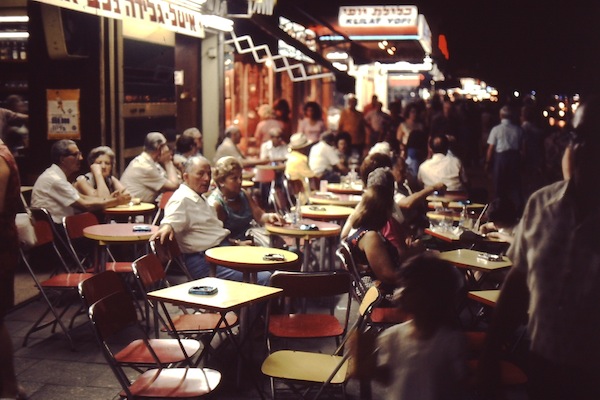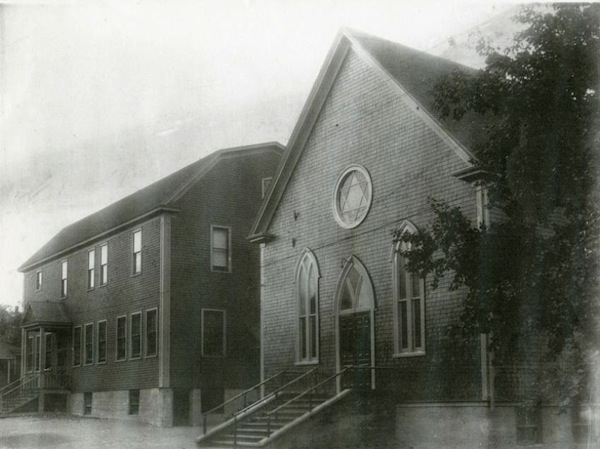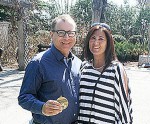Hundreds of thousands came out to watch Toronto’s Pride Parade on June 28 despite the inclement weather. (photo by Najin Lin via facebook.com/pridetoronto)
Years ago, at a particularly low point, Chaim Silver (not his real name) was so desperate to be straight that he ingested a white powder that a naturopath had sent to him by mail, claiming it had “cured” a lesbian of her same-sex desires.
“I actually took it,” Silver laughed over the phone. “It was before anthrax, before 9/11.”
Silver is Modern Orthodox and came out to his parents when he was in his late 20s. While they’ve never explicitly rejected him, he said their approach has always been, “We can fix this.”
Over the years, they’ve oscillated between encouraging Silver to marry a woman and presuming he’ll accept a life of celibacy. “They’ve said to me, ‘You’ll just make your life about your siblings’ kids,’” said Silver, who is now in his 40s.
They’ve also suggested he try reparative therapy, a controversial practice that aims to make a homosexual person heterosexual. But, more than anything, Silver’s sexual identity is something about which his parents, plus many people at the Orthodox synagogue he attends in Toronto – most of whom, Silver believes, know about his sexuality – say nothing.
He once went away on a trip with a non-Jewish boyfriend, he noted, and nobody in his family acknowledged it.
“At synagogue, if I’m single, celibate and alone … I don’t think anyone actually cares … they’ll give me aliyot. But if I’m going to have a partner and want a life that’s celebrated, I don’t think that can happen in orthodoxy.”
On the whole, Silver said he’s grown pessimistic about the notion – touted by activists such as Rabbi Steven Greenberg, dubbed the only openly gay Orthodox rabbi in North America – that Orthodox Judaism can make space for homosexual people. “The two seem incongruous to me. [Being gay is] this innate thing that’s felt to be prohibited,” Silver said. “Not everything can be fixed in life. As you get older, you realize that some things just suck.”
Silver’s cynicism and his parents’ denial are arguably more acute because of Orthodox Judaism’s strict adherence to Torah, but anecdotal evidence shows that many Jewish parents from more liberal denominations are also uncomfortable having an LGBTQ kid and default to silence on the matter.
Justine Apple, executive director of Kulanu Toronto, a Jewish LGBTQ social and cultural group, said Jewish parents, ranging from secular to Modern Orthodox, have reached out to her, seeking counsel about their children’s sexual orientation. “People who are Orthodox tend to have a harder time dealing with this but, at the end of the day, it’s an individual process,” she said. “There are still so many parents in the community who know their kids are gay but are very secretive about it.”
Apple said when she herself first came out, her family, who have since made huge strides, didn’t want to hear about her personal life, making her feel “invisible.”
Many parents won’t ask their LGBTQ children about their romantic lives due to internalized homophobia and ignorance about what it means to be gay, she said. “A lot of parents equate being gay with what happens in the bedroom. But queer Jews, like any Jews, connect to their loved ones on multiple levels – emotional, spiritual, intellectual.”
Parents should recognize that being gay isn’t a choice and doesn’t negate that “we still have Jewish values, we’re still connected to family, community,” Apple said. “It’s important for parents to give kids support, make them feel part of family gatherings and ask them what’s happening in their personal lives.”
Apple said she reached out to several LGBTQ Jewish colleagues and friends to see if their parents would speak to the CJN about their experiences of their children coming out, but all of the parents declined. “It seems to be a sensitive topic for parents, more so than for their children,” she noted.
Maya Benaim (not her real name) came out a decade ago to her parents, who belong to a Conservative synagogue. She joked that she wishes they had taken some kind of course. “They didn’t understand it, and I wasn’t the person who could explain. It was too personal for me,” she said.
Over the years, her parents have rarely inquired about her partners and haven’t known how to act when one of her relationships ended. “I learned not to mention stuff.… I’d be going through tremendous pain from a breakup and would have to hide it from them,” she said.
Benaim, 30, said she’d be happy for her parents to seek external support – “anything that would contribute to understanding and de-stigmatizing and improve our relationship” – but she’s adamant that the onus not be on her to “hold their hands” through the process. “I’m already in pain enough from them not understanding,” she said. “I’d really appreciate if the community stepped in for that sort of thing. I think that’s what being an ally is about – doing that work so the people who are the victims of misunderstanding or hate don’t have to.”
Toronto social worker Elsia La Caria works with adolescents and young adults. She said for someone who’s come out, negative reactions from parents typically aggravate existing issues. “The person is often already struggling with feelings of not being accepted, so when the people closest to them don’t provide the right support, this can exacerbate their feelings of loneliness, sadness and feeling excluded,” she said.
Regarding parents’ silence about a child’s sexuality, she said, “this can reinforce the idea that they’re different in a bad way, that they don’t belong anywhere.”
Rabbi Michael Dolgin is senior rabbi of Toronto’s Reform Temple Sinai Congregation, where he and associate Rabbi Daniel Mikelberg officiate at same-sex weddings.
Canada’s legalization of same-sex marriage has helped affirm that “same-sex life is consistent with a focus on family, continuity and other Jewish values that I think, in the past … people assumed [LGBTQ people] were breaking with,” Dolgin said.
While parents of LGBTQ kids occasionally seek his guidance, Dolgin said young people nowadays generally seem more comfortable “being out,” and the North American Federation of Temple Youth, the youth group affiliated with the Reform movement, is widely considered a safe space for LGBTQ youth to participate without “the stress of having to choose between being Jewish and being homosexual.” The best response to a child who has come out is to love them, to listen and to work toward “an open, understanding relationship in which they can express their feelings,” he added.
Apple stressed that parents have a responsibility to educate themselves about what it means to be gay and Jewish. Kulanu’s doors are open to those seeking a safe space to discuss this, she said, but support is offered on more of an informal basis and she may refer families to Jewish Family and Child Service, and non-Jewish organizations such as PFLAG Canada and the 519, a Toronto agency that “respond[s] to the evolving needs of the LGBTQ community, from counseling services and queer parenting resources to coming out groups, trans programming and seniors support.”
“Right now, our goal is primarily to run events for the LGBTQ community and its allies,” said Apple.
Resources geared to Jewish families in this situation are only available in Canada “in pockets,” and are less abundant than in the United States, she acknowledged.
There’s a need in the community for more “open forums [for parents] to share their fears and concerns,” Apple said, adding that she sees future opportunities for Kulanu to develop a network to help parents who are struggling.
Indeed, Silver’s sense of hopelessness is tied, at least in part, to location. Toronto’s Jewish community is quite religiously conservative, unlike New York’s, where a Friday-night minyan of Orthodox LGBTQ Jews launched last year, he said.
Dating has been tough as it is – a secular Jewish partner couldn’t understand why Silver wanted to belong to a world that didn’t accept him, while a non-Jewish boyfriend wouldn’t give up Christmas – without the added problem that many in his position have left the Orthodox community or remain in hiding. “Many of us have simply disappeared,” he said, “so it’s not an issue the Orthodox community feels they have to face.”
Rabbi Noah Cheses, assistant rabbi at Shaarei Shomayim Congregation, one of Toronto’s largest Modern Orthodox shuls, said that supporting young people and their parents as the former share their sexual orientation with family and friends is an issue he cares deeply about. “But I try to take a line that distinguishes between supporting and endorsing. It’s a fine line. I can support an individual with the struggles he or she has, but I’m reluctant to endorse a lifestyle or culture that runs in opposition to a verse in the Torah, though I understand that being gay is not a choice,” he said.
Having recently moved to Toronto from Connecticut, he said he knows of several groups and online networks that support LGBTQ Orthodox people and their families there, but he isn’t aware of similar organizations in the Toronto area.
“On many different social and gender-related issues, my sense is Toronto has been not as advanced as many modern Orthodox communities in the States,” he said.
– For more national Jewish news, visit cjnews.com.














